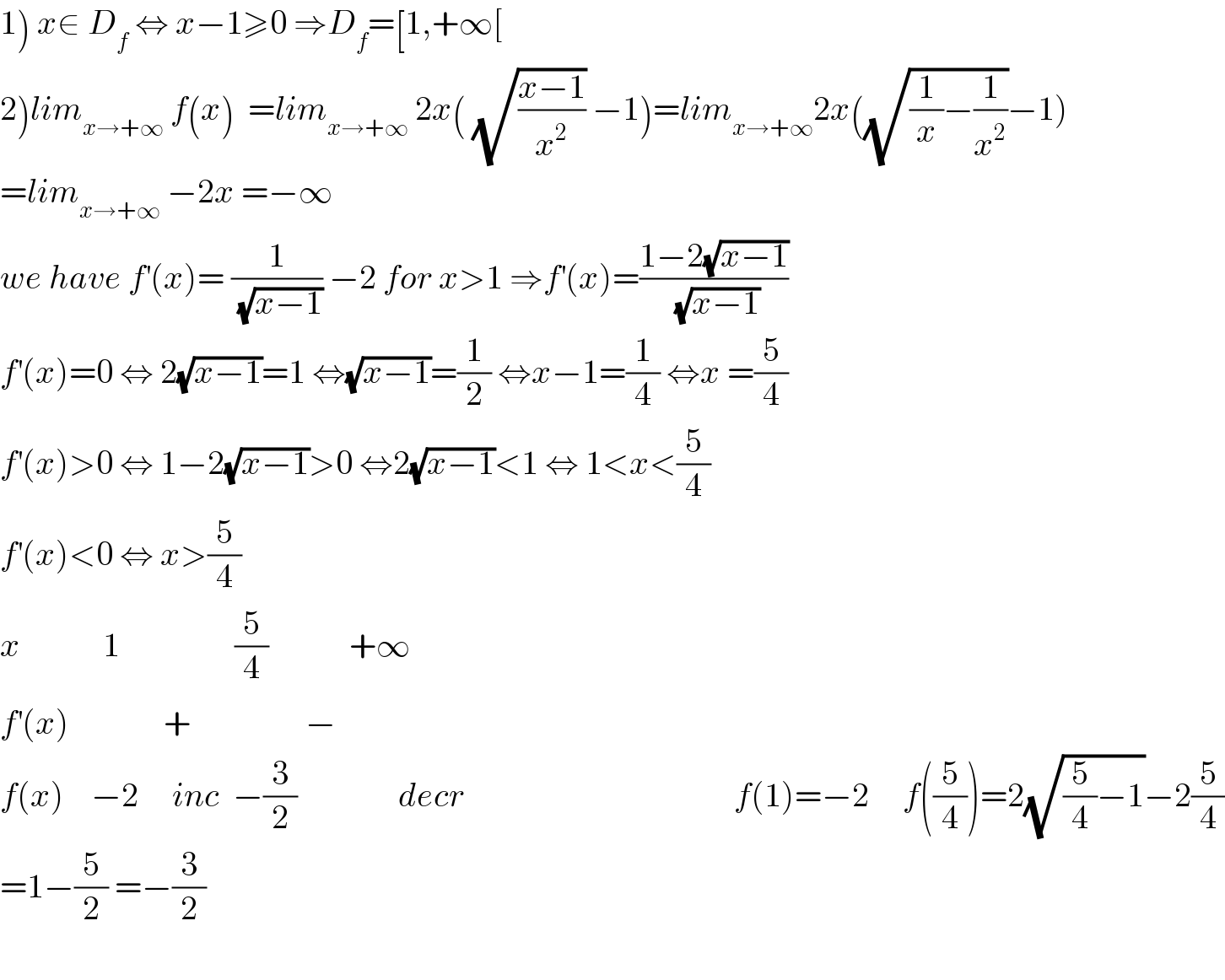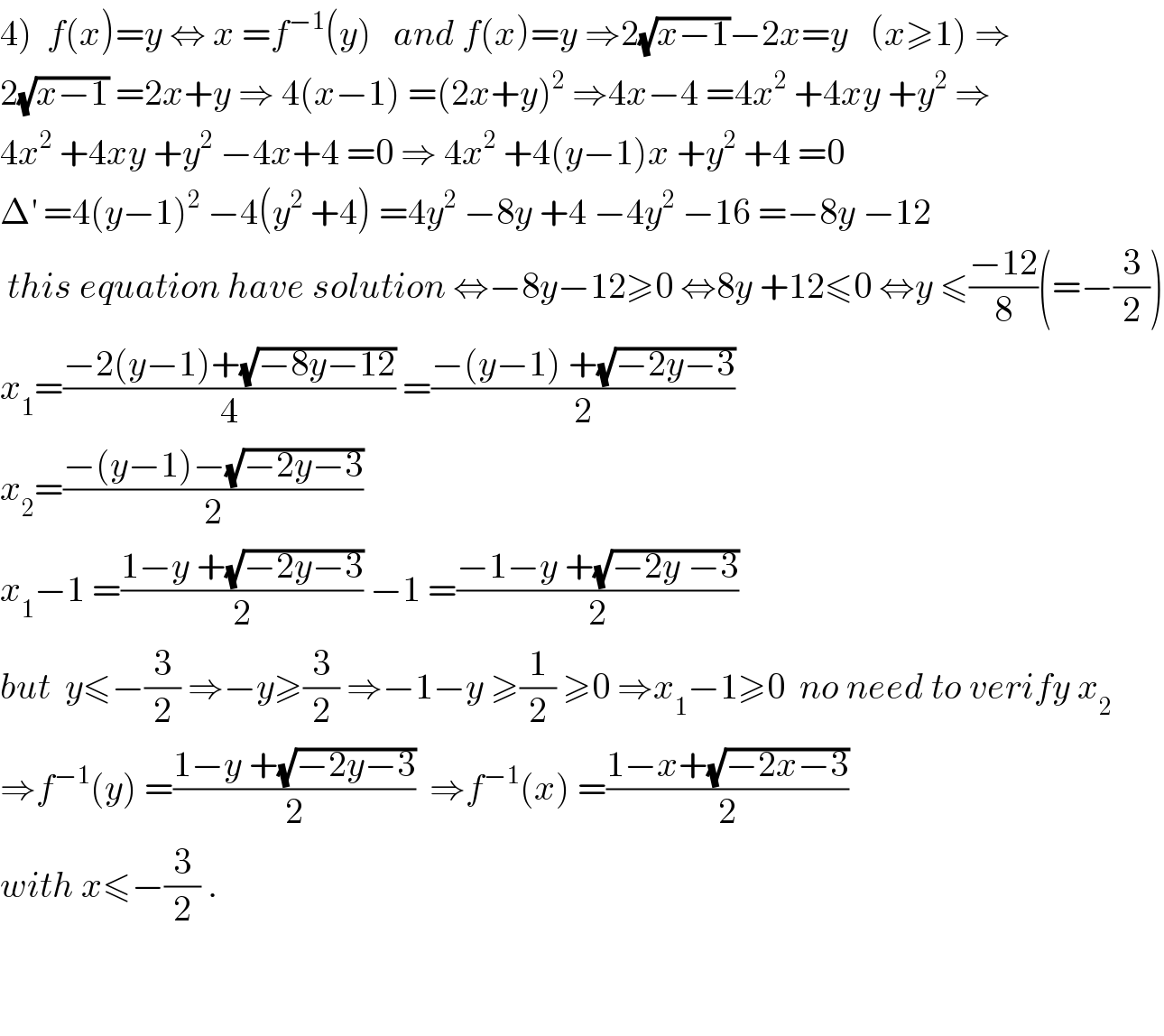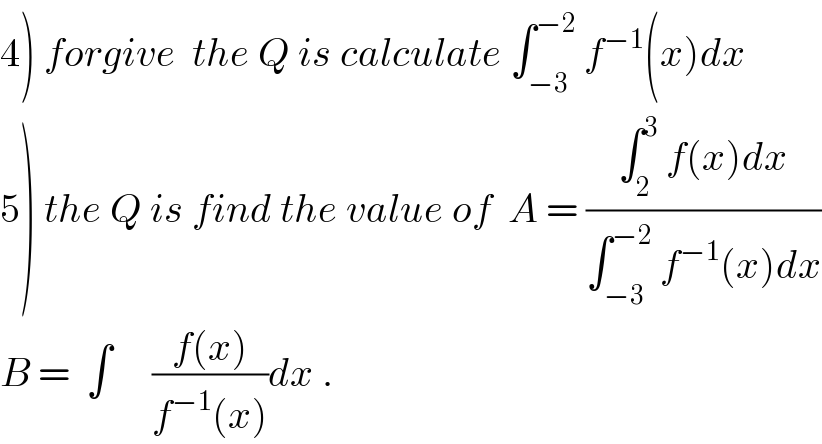
Question and Answers Forum
Question Number 42631 by maxmathsup by imad last updated on 29/Aug/18

Commented by bbnnftm833 last updated on 30/Aug/18

Commented by maxmathsup by imad last updated on 31/Aug/18

Commented by maxmathsup by imad last updated on 31/Aug/18
![3) ∫_1 ^3 f(x)dx = ∫_1 ^3 {2(√(x−1))−2x}dx = 2 [(2/3)(x−1)^(3/2) ]_1 ^3 − [x^2 ]_1 ^3 =(4/3){ 2^(3/2) } −(9−1) = (4/3)(√2^3 ) −8 =(4/3)(2(√2)) −8 =((8(√2))/3) −8 .](Q42662.png)
Commented by maxmathsup by imad last updated on 31/Aug/18

Commented by maxmathsup by imad last updated on 31/Aug/18

Commented by maxmathsup by imad last updated on 31/Aug/18
![4) we have f^(−1) (x)=((1−x+(√(−2x−3)))/2) ⇒ ∫_(−3) ^(−2) f^(−1) (x)dx =(1/2) ∫_(−3) ^(−2) (1−x) +(1/2) ∫_(−3) ^(−2) (√(−2x−3))dx but ∫_(−3) ^(−2) (1−x)dx =[x−(x^2 /2)]_(−3) ^(−2) =−2−2−(−3−(9/2))=−1 +(9/2) =(7/2) and ∫_(−3) ^(−2) (√(−2x−3))dx =[−(1/3)(−2x−3)^(3/2) ]_(−3) ^(−2) =−(1/3){1−(3)^(3/2) } =(√3) −(1/3) ⇒∫_(−3) ^(−2) f^(−1) (x)dx = (7/4) +((√3)/2) −(1/6) =((38)/(24)) +((√3)/2) =((19)/(12)) +((√3)/2)](Q42675.png)
Commented by maxmathsup by imad last updated on 31/Aug/18
![5) we have ∫_2 ^3 f(x)dx = 2 ∫_2 ^3 (√(x−1)) −∫_2 ^3 2x dx =2[(2/3)(x−1)^(3/2) ]_2 ^3 −[x^2 ]_2 ^3 =(4/3){ 2^(3/2) −1}−{9−4} =(4/3)(2(√2)) −5 =((8(√2))/3) −5 also we have ∫_(−3) ^(−2) f^(−1) (x)dx =((19)/(12)) +((√3)/2) ⇒ A = ((∫_2 ^3 f(x)dx)/(∫_(−3) ^(−2) f^(−1) (x)dx)) = ((((8(√2))/3)−5)/(((19)/(12)) +((√3)/2))) .](Q42676.png)
Answered by behi83417@gmail.com last updated on 30/Aug/18
![1)x−1≥0⇒x≥1⇒D_f =[1,+∞) 2)y=2(√(x−1))−2x y′=(1/(√(x−1)))−2⇒x≠1⇒D_f =(1,+∞) x−1=t^2 ⇒x=t^2 +1 f(t)=2t−2(t^2 +1)=−2(t^2 −t+1) ⇒t^2 −t+1=((−y)/2)⇒(t−(1/2))^2 =((−y)/2)−(3/4) ⇒t−(1/2)=±(√(−((2y+3)/4)))⇒t=(1/2)(1±(√(−2y−3))) ⇒(√(x−1))=(1/2)(1±(√(−2y−3))) ⇒x=1+(1/4)(1±(√(−2y−3)))^2 ⇒f^(−1) (x)=1+(1/4)(1±(√(−2x−3)))^2 −2y−3≥0⇒2y+3≤0⇒y≤−(3/2) ⇒R_f =(−∞,−(3/2)]. 3)∫_1 ^3 f(x)dx=∫_1 ^3 (2(√(x−1))−2x)dx= =[(4/3)(x−1)^(3/2) −x^2 ]_1 ^3 =8(((√2)/3)−1). 4)∫f^(−1) (x)dx=∫[1+(1/4)(1±(√(−2x−3)))^2 ]dx= =∫[1+(1/4)(1∓(2x+3)±2(√(−2x−3)))]dx I_1 =∫[1+(1/4)(2x+4+2(√(−2x−3)))]dx= =(1/2)(2x+(((x+1)^2 )/2)−(1/3)(−2x−3)^(3/2) )_1 ^3 = =(1/2)[6+8−27i−2−2+((i(√5))/3)]= =5−((81−(√5))/6).i](Q42660.png)
